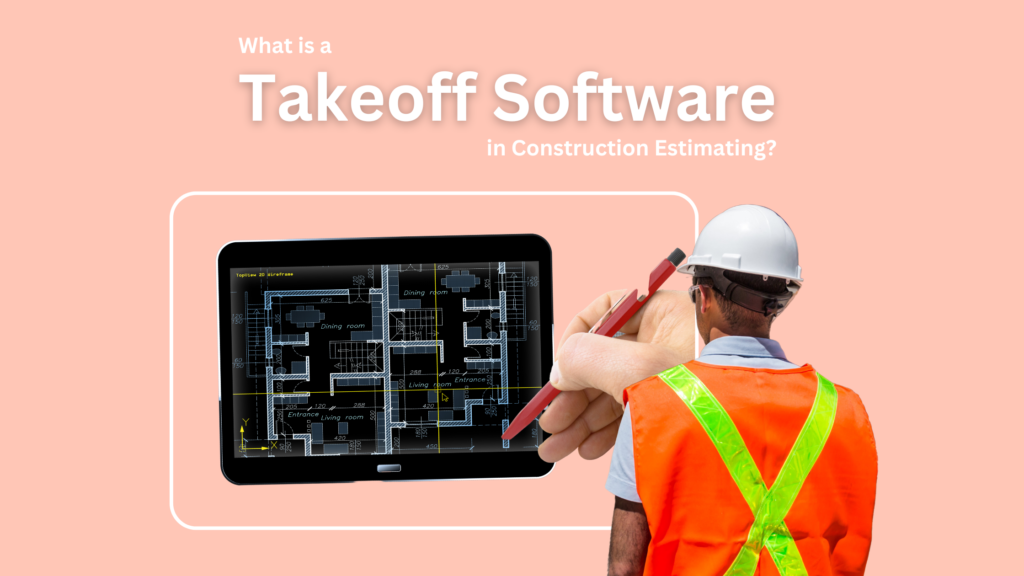
Introduction
Estimating is the backbone of any construction project. Get it right, and your project runs smoothly with profits in sight. Get it wrong, and you’re left with budget overruns, project delays, and unhappy clients. Yet, many contractors still rely on outdated methods like paper blueprints, manual calculations, and guesswork.
Enter takeoff software for construction estimating—a game-changer that eliminates errors, saves time, and improves cost accuracy. But here’s the thing: many construction professionals either don’t know about these tools or have them but aren’t using them to their full potential. That’s exactly what we’ll uncover in this guide. By the end of this blog, you’ll know exactly how takeoff software works, why it matters, and how to choose the best one for your needs.
What is Takeoff Software?
Takeoff software is a digital tool that helps contractors, estimators, and project managers measure materials and labor requirements from blueprints and construction drawings. Instead of manually calculating how much concrete, steel, or drywall you need, takeoff software does it for you—faster and with pinpoint accuracy.
How Does It Differ from Manual Estimating?
Traditional takeoff involves printed plans, rulers, calculators, and highlighters. Not only is this time-consuming, but it also leaves plenty of room for human error. Imagine missing a measurement or miscalculating material quantities—suddenly, your project is short on supplies, causing delays, cost overruns, and unnecessary stress.
Takeoff software eliminates these risks by automating material quantity calculations, reducing human error, and integrating directly with estimating tools. It allows construction professionals to make informed decisions with real-time data instead of relying on gut feelings or outdated spreadsheets.
Benefits of Using Takeoff Software in Construction Estimating
Enhanced Accuracy
Manual takeoffs are susceptible to human error, leading to inaccurate estimates. Takeoff software minimizes these errors by providing precise measurements. According to ConstructConnect, utilizing construction takeoff software reduces the time required for takeoffs, allowing more time to ensure estimates and bids are complete, competitive, and profitable.
Time Efficiency
Time is a valuable resource in construction. Automated takeoff tools significantly reduce the time spent on measurements. Estimating Edge highlights that integrated construction takeoff and estimating software can help reduce errors, improve the accuracy of cost estimates, save time, and improve efficiency.
Improved Collaboration
Modern takeoff software often includes cloud-based features, allowing multiple team members to access and work on the same project simultaneously. This real-time collaboration ensures that everyone is on the same page, reducing miscommunications and enhancing project cohesion.
Cost Savings
Accurate estimates prevent over-ordering or under-ordering materials, leading to cost savings. By providing precise material counts, takeoff software helps in budgeting accurately and avoiding unnecessary expenses.
Key Features to Look for in Takeoff Software
Selecting the right takeoff software is pivotal for construction professionals aiming to enhance accuracy, efficiency, and collaboration in their projects. Here are seven key features to consider:
1. 2D and 3D Takeoff Capabilities
Modern takeoff software should offer both 2D and 3D functionalities. While 2D takeoffs involve traditional blueprint measurements, 3D capabilities enable interaction with Building Information Modeling (BIM) files, providing a more detailed view of the project. This dual capability allows estimators to visualize complex structures more comprehensively, leading to more accurate material and labor estimations. According to Estimation Guru, platforms that include both 2D and 3D takeoff capabilities enhance the precision of project analysis.
2. Integration with Estimating and Project Management Software
Seamless integration with other tools ensures a smooth workflow. For instance, linking takeoff data directly to estimating software eliminates the need for manual data entry, reducing the risk of errors and saving time. This integration streamlines the transition from the takeoff phase to budgeting and scheduling, ensuring consistency across all project stages. As noted by ConstructConnect, using construction takeoff software decreases the time required for takeoffs, allowing more time to ensure estimates and bids are complete, competitive, and profitable.
3. User-Friendly Interface and Automation
A straightforward interface with automation features reduces the learning curve and increases efficiency. Features like drag-and-drop functionality and automated measurement recognition can expedite the takeoff process. An intuitive design ensures that team members can quickly adapt to the software, minimizing training time and enhancing productivity. Research emphasizes that intuitive interfaces reduce the learning curve and speed up adoption across teams.
4. Cloud-Based Access and Real-Time Updates
Cloud-based platforms offer the advantage of accessing project data from anywhere, facilitating remote work and collaboration. Real-time updates ensure that all team members have the latest information, enhancing decision-making. This feature is particularly beneficial in today’s dynamic work environments, allowing for flexibility and timely responses to project changes. According to Estimating Edge, integrated construction takeoff and estimating software can help reduce errors, improve the accuracy of cost estimates, save time, and improve efficiency.
5. Pre-Built Material Databases
Having access to a comprehensive database of materials with current pricing allows for quick and accurate cost estimates. This feature ensures that your estimates reflect market conditions, aiding in competitive bidding. Regular updates to these databases are crucial to account for price fluctuations, ensuring that budgets remain accurate and up-to-date. As highlighted by SoftwareWorld, the best construction takeoff software offers features like digital plan import, measurement tools, and integration with project management platforms.
6. Customizable Templates and Reports
The ability to create and modify templates and reports ensures that the software can adapt to various project requirements. Customized reports can provide insights tailored to specific stakeholder needs, enhancing communication. This flexibility allows for the presentation of data in formats that are most relevant to different audiences, facilitating better understanding and decision-making. According to Togal.AI, takeoff software comes endowed with an array of vital features tailor-made to streamline the pre-construction process, aid in accurate estimations, and foster effective collaboration.
7. Measurement and Annotation Tools
Advanced measurement tools, such as linear, area, and volume calculators, along with annotation features, allow for detailed plan analysis. These tools ensure that all aspects of the project are considered, leading to more accurate estimates. Annotations can highlight critical areas, note potential issues, or provide instructions, ensuring that important information is clearly communicated to all team members. As noted by Construction Coverage, takeoff tools can offer features to speed up and improve the accuracy of the takeoff process for contractors and subcontractors.
How to Implement Takeoff Software in Your Construction Business
Assessing Your Company’s Needs
Begin by evaluating your current estimating process to identify areas that need improvement. Consider factors like project size, complexity, and the types of projects you typically handle.
Training Your Team
Invest in comprehensive training to ensure your team can effectively use the new software. Many providers offer tutorials, webinars, and support to facilitate this process.
Integrating with Existing Systems
Ensure that the takeoff software can integrate with your current systems, such as project management and accounting tools. This integration streamlines workflows and prevents data silos.
Measuring Success and ROI
After implementation, monitor key performance indicators (KPIs) like time saved, estimate accuracy, and bid success rates to assess the software’s impact. This evaluation will help determine the return on investment and identify further optimization opportunities.
Common Challenges and How to Overcome Them
1. Resistance to Change
Employees accustomed to traditional methods may be hesitant to embrace new technology. To mitigate this, involve team members early in the selection process, emphasizing how the software can reduce workloads and increase accuracy. Providing thorough training and support can ease the transition. As noted by Foundation Software, employee pushback is common when introducing new tools; involving employees early and providing hands-on training can help ease the transition.
2. Data Migration Issues
Transferring data from legacy systems can be complex and time-consuming. To overcome this, plan meticulously by cleaning existing data and utilizing import tools provided by the new software. This preparation ensures a smoother transition and minimizes the risk of data loss or corruption. According to BuildOps, initial setup, including data entry and customization, can be time-consuming; leveraging available training and support can facilitate this process.
3. Ensuring Data Accuracy
Maintaining accurate and up-to-date data is crucial for reliable estimates. Regularly update material databases and verify all measurements and calculations. Implementing quality control procedures, such as routine audits and cross-verification, can help maintain data integrity. Regularly updating pricing databases is essential for accurate estimates.
Conclusion
Embracing takeoff software can transform your construction estimating process, leading to enhanced accuracy, efficiency, and cost savings. By understanding and utilizing the full capabilities of these tools, construction professionals can stay competitive and deliver successful projects.
At bldon.com, we provide powerful and user-friendly takeoff software designed to streamline your construction estimating process. Get started today and experience the benefits of accurate, efficient project planning. Visit bldon.com to learn more and take your business to the next level.
Frequently Asked Questions (FAQs)
1. What is construction takeoff software?
Construction takeoff software is a digital tool that helps contractors and estimators calculate the quantities and costs of materials needed for a construction project. It simplifies the process of analyzing blueprints and plans, making estimating faster and more accurate.
2. How does takeoff software improve estimating accuracy?
By automating measurements and calculations, takeoff software reduces manual errors, leading to more precise estimates. This accuracy helps in creating realistic budgets and timelines, minimizing the risk of cost overruns and project delays.
3. Can takeoff software integrate with other construction management tools?
Yes, many takeoff software solutions offer integration with estimating and project management software. This integration streamlines workflows, ensuring consistency across all project stages and enhancing overall efficiency.
4. Is takeoff software suitable for small construction businesses?
Absolutely. There are takeoff software options designed specifically for small businesses, offering essential features at an affordable price point. These tools can help small contractors compete more effectively by improving estimating accuracy and efficiency.
5. What are the common challenges when implementing takeoff software?
Common challenges include resistance to change, data migration issues, and ensuring data accuracy. Addressing these challenges involves involving team members early in the selection process, planning for data migration, and implementing quality control procedures to maintain data integrity.


